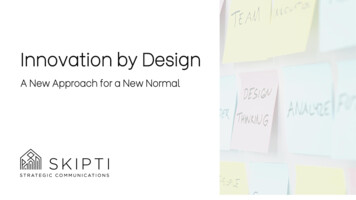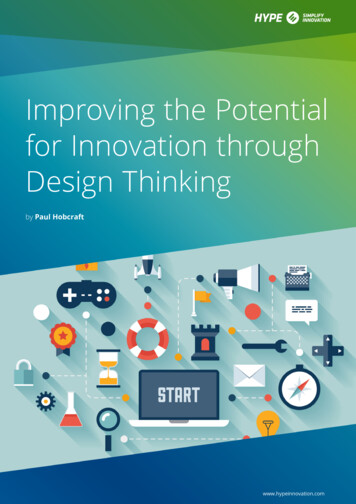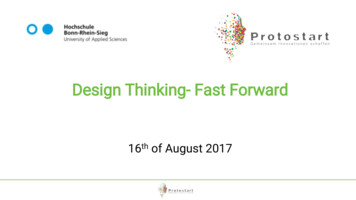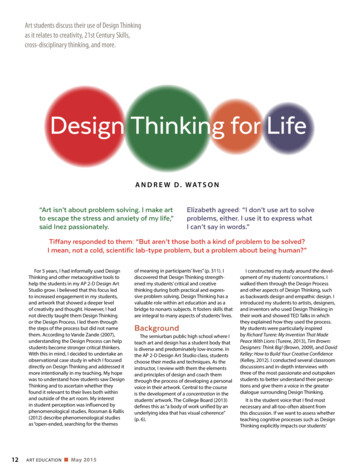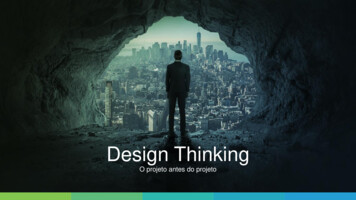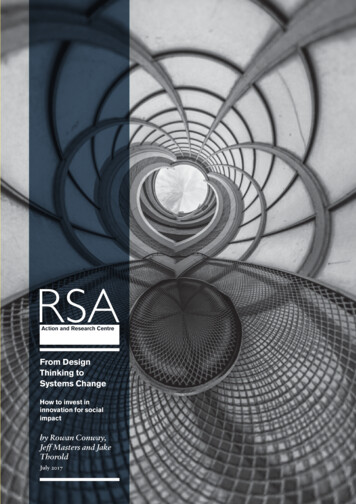
Transcription
From DesignThinking toSystems ChangeHow to invest ininnovation for socialimpactby Rowan Conway,Jeff Masters and JakeThoroldJuly 2017
ContentsExecutive summary3Marrying design and systems thinking5Thinking like a system11Acting like an entrepreneur18SBRI as a catalyst for human centred innovation20Conclusions25Bibliography27
About the authorsRowan Conway is the Director of Innovation and Development at theRSA. She ensures that the RSA is undertaking rigorous, profile raising andinfluential research and innovation projects. She has previously workedas a business journalist and editor and in community involvement andparticipation for London 2012.Jeff Masters is an associate at the RSA. He was previously a Tresuryofficial, a policy advisor to Chuka Umunna MP and secretary to the crossparty Commission on 2020 Public Services based at the RSA. He holds aMaster of Public Policy degree from the Kennedy School of Government,Harvard University.Jake Thorold is a research assistant at the RSA focusing on a range oftopics from Universal Basic Income to government innovation. He workedpreviously for Clinton Global Initiative in New York.About the RSAThe RSA (Royal Society for the encouragement of Arts, Manufacturesand Commerce) believes that everyone should have the freedom andpower to turn their ideas into reality – we call this the Power to Create.Through our ideas, research and 27,000-strong Fellowship, we seek torealise a society where creative power is distributed, where concentrationsof power are confronted, and where creative values are nurtured. The RSAAction and Research Centre combines practical experimentation withrigorous research to achieve these goals.AcknowledgementsThe RSA is grateful to have received the support of Innovate UK forthis work. Innovate UK is the UK’s innovation agency. They work withpeople, companies and partner organisations to drive and find and drivethe science and technology innovations that will grow the UK economy.Since 2007 they have helped more than 7,600 organisations with projectsestimated to add more than 11.5 billion to the UK economy and create55,000 extra new jobs.The authors would also like to thank the following: the attendees of theroundtable seminar on SBRI held at the RSA in March 2017; the SBRIcommissioners and participants who generously gave their time for interviews; at Innovate UK, Kevin Baughan and Stephen Browning; at the RSA,Kenny McCarthy, Amanda Kanojia, Anthony Painter, Tony Greenhamand Matthew Taylor; and finally Nic Hinton, Professor Stephen Roper,Professor John Rigby and Mary Stevens for their invaluable help.The RSA inpartnership with
Executive summaryAchieving change in a world ever more defined by complexity is difficult.We face an array of complex ‘wicked’ problems, from an ageing population to climate change to intergenerational cycles of poverty. It can oftenseem that these challenges are insurmountable and that we lack the abilityto make meaningful change.To find opportunity in challenge will require reimagining the ways thatwe currently think about innovation and design. The narrative arounda ‘fourth industrial revolution’ risks narrowing the focus of innovationto technology which would locate innovation-led growth solely in theoutputs of universities and research institutes, or technology clusters likeCambridge’s Silicon Fen. While these are a vital piece of the UK’s innovation jigsaw, they are not the whole picture. Enterprises large and smallacross sectors and regions need to also be part of the innovation mix.The UK has long been at the forefront of design, a rich heritage thatpermeates a diverse range of sectors. Design thinking methodologiesare deployed in service, policy and governance design across sectors, notmerely product design. Harnessing the power of this creative capacity willbe crucial to generating the innovative solutions required to tackle pressing social challenges.But design thinking alone will not be enough. The core insight of thispaper is that solving our most complex problems will require augmentingdesign thinking with a systems thinking approach as the basis for action.While design thinking has proved itself to be successful in the realmof creating new products and services, the challenge is how to supportinnovations to enter and actively shape the complex systems that surroundwicked social challenges.Great design doesn’t always generate impact. As we show in thisreport, innovations attempting to scale and create systemic change oftenhit barriers to change, sending them catapulting back to square one. Wecall this the ‘system immune response’. The particular barriers will differdependent on context, but might be cultural, regulatory, personalitydriven or otherwise. This report argues that innovations for the publicgood are susceptible to the system immune response because there is adeficit of systems thinking in design methodologies.This report introduces a new RSA model of ‘think like a system, actlike an entrepreneur’ as a way of marrying design and systems thinking.At its most simple, this is a method of developing a deep understanding ofthe system being targeted for impact and then identifying the most promising opportunities to change based on that analysis – the entrepreneurialpart. By appreciating factors like power dynamics, competing incentivesand cultural norms, innovators can prepare themselves for barriers tochange, and find the entrepreneurial routes around them to successfullyaffect system change.From Design Thinking to System Change3
This report takes the Small Business Research Initiative (SBRI), a twophase pre-procurement innovation programme that aims to match socialchallenges with new ideas, as its primary case study. It suggests augmenting the excellent design thinking deployed through SBRI with a thinklike a system, act like an entrepreneur lens in order to drive better socialoutcomes from SBRI-originating innovations. Programmes like SBRI havegreat potential to drive change and address pressing challenges, but mustbe guided by a more developed understanding of how change happens.The stakes are too high to not raise our game when it comes tosocial innovation. Wicked problems can be overcome but will requiresophisticated theories of change able to account for the complexity andunpredictability of modern life. We offer think like a system, act like anentrepreneur as a contribution to this effort.This report is based on the following research: Desk based review of relevant literature; A series of structured interviews with participants in SBRIcompetitions; and An expert round table that brought together policymakers, commissioners, procurement experts and entrepreneurs to considerand develop initial findings.4From Design Thinking to System Change
Marrying design andsystems thinkingWe sit on the cusp of a fourth industrial revolution, with automation,robotics, machine learning and biotechnology promising to transformtransport, medicine, social care, communication and more, and extendhuman capabilities in remarkable ways. But these new industrial advancesalso threaten to disrupt the labour market and create profound instabilityand public anxiety. For this industrial revolution to be “empowering andhuman-centred, rather than divisive and dehumanizing”1 as Founder ofthe World Economic Forum Professor Klaus Schwab hopes, we must thinkdeeply about the social challenges we face, while innovating in new waysto meet the human needs of the future.This might suggest a need for a human-centred industrial strategy,one that takes tackling the real problems faced by ordinary people as acore metric of success rather than solely economic growth. This strategyshould be enabled by a combination of design methodologies and systemsthinking, working together to unleash the empowering potential of innovation. At the RSA we argue for the need to adopt a process of ‘thinkinglike a system and acting like an entrepreneur’ if the country is to meet thisimperative.The design economyIn recent years there has been a surge in the use of design methods tostimulate innovation. Public and private agencies have opened up challenge prizes and competitions that have stimulated markets, and the UKGovernment has promoted a range of design-led innovation processes.Innovate UK is ambitious about the potential of design to stimulateinnovation and accelerate economic growth through “the wider take-upof impactful design across industry sectors and challenge areas.” Its 2015Design in Innovation strategy2 states: “Our aim is for UK businesses to innovate better, grow faster and achieve greater commercial success throughthe effective use of excellent early-stage design.”The UK is a world leader in design. According to the Design Council’sDesign Economy report3, design activity generated 71.7bn in grossvalue add (GVA) in 2013. There is now an opportunity for UK plc to use1. Schwab, K. (2006) The Fourth Industrial Revolution. Portfolio Penguin: London.2. Innovate UK (2015) Design in innovation: Strategy 2015 – 2019. Available at: ds/attachment data/file/474557/Design inInnovation Strategy 2015-2019 WEB.pdf.3. Design Council (2015) The Design Economy: The value of design to the UK. Available b%20Final%20-%20140217%20Yea%201.pdf.From Design Thinking to System Change5
design methodologies in early stage innovation to deliver improved social,economic and environmental impacts. Designers can reframe socialand environmental issues like healthcare or climate change as creativeopportunities. As Innovate UK says: “Identifying and tackling the ‘right’problems: working with designers to utilise their problem solving skills onbroader challenges can help businesses and organisations identify genuineeconomic, social and environmental viable opportunities, rather thanconcentrate on ‘solutions looking for a problem’”.4Designers are increasingly alert to the innovation potential of socialchallenges. In a 2017 RSA lecture5, Jeremy Myerson, founder of the HelenHamlyn Centre at the Royal College of Art, urged designers and entrepreneurs to respond to the challenge of an ageing population. As well asproviding for a social good, Myerson identified the potential dividendthat an ageing population provides for designers, with new retail marketsemerging for products like the ‘grankini’ – an all-in-one high tech undergarment that supports mobility for the elderly.But where a clear commercial market doesn’t exist, government agencies and charitable organisations can also create demand, by procuringinnovations directly to support social change or improvements in publicservices. An example of this is the Small Business Research Initiative, avehicle through which government agencies can run competitions predicated on particular problems that need solving.Deploying design thinkingIn Democratising Innovation6, Eric von Hippel argues that we have movedinto a ‘user-centred’ as opposed to ‘manufacturer-centric’ era of innovation. As Jeanne Liedtka said in the 2015 Batten Briefing on Innovation andGrowth7: “The most secure source of new ideas that have true competitiveadvantage, and hence, higher margins, is customers’ unarticulated needs.”Businesses are now routinely generating innovation using human centredmethods. These processes employ user research, experimentation, prototyping, and iteration and foster innovations that meet a particular humanneed rather than being purely product-driven. These methods have beenused to inform design innovations in everything from airline flatbeds atBritish Airways8 to breathable sportswear at Nike9.Design-led innovation has demonstrated a clear dividend in consumerfacing industries, and design thinking is no longer the preserve of productdevelopers. The process also generates service solutions, new conceptsand governance models, and it is being used to envisage new businessstrategies and services across sectors, including the public sector. An4. Innovate UK (2016) Design in Innovation: Early Stage Interventions. Available at: ignBook FINAL web-version.pdf.5. Myerson, J. (2017) Social Challenge – Design Dividend. RSA Event. Available at: enge---design-dividend.6. Von Hippel, E. (2005) Democratizing Innovation. The MIT Press: Boston, USA. Availableat: pdf.7. Glinska, M (2014) Innovation and Growth: Understanding the Power of DesignThinking. Batten Institute. Available at: ing121814-issuu.8. Tangerine. Club World: British Airways. Webpage. Available at: ign-british-airways-club-world/.9. Brownlee, J. (2013) Nike’s 5 Lessons on Innovation by Design. Co-design (webpage).Available at: ns-on-innovation-by-design6From Design Thinking to System Change
insurgency of open innovation labs and innovation districts in cities haveemerged, such as Sitra in Finland, MindLab in Denmark, 18F in the US,and Policy Lab in the UK to test the methods on public policy. Challengeprizes and grant funds have been earmarked to stimulate design thinkingand Innovate UK is currently investing up to 2m in early-stage, humancentred design projects with its Design Foundations Fund. Social impactinvestment funds are also seeking to drive innovation for public goodfurther, prominent recent examples being Big Society Capital Fund andthe Cabinet Office’s Funds for Social Impact Bonds.Design thinking is by definition exploratory: solutions are developed, prototyped and tested using iterative, ‘safe-fail’ experiments to gain rapid feedback.The double diamond method developed by the Design Council is a widelyrecognised way to deploy design thinking. As Figure 1 illustrates, it is a methodthat helps to uncover a problem by using a collaborative and iterative approach,and then reengaging in divergent and iterative thinking to arrive at a solution.The process does not commit at the outset to the form of an end solution butrather generates ideas that could ultimately become physical or digital products, services or processes.Figure 1: The Design Council Double DiamondThe potential for design thinking in public sector innovation is substantialand varied. In their review of studies on innovation in the public sector,De Vries et al10 show the range of innovation types that can be stimulated: Process innovations, including the creation of new organisa-tional forms and working methods; or the creation or use of newtechnologies to improve services; Product or service innovations, the creation of new publicservices or products;10. De Vries, HA., Bekkers, VJJM., and Tummers, LG. (2014) Innovation in the PublicSector: A Systematic Review and Future Research Agenda. Public Administration. Vol. 94, No.1. 146-166.From Design Thinking to System Change7
Governance innovations, the development of new governanceforms and processes to address specific social problems; and Conceptual innovations, such as new concepts, frames ofreference or paradigms to change the understanding of problemsand/or their solutions.From design thinking to systems thinkingExcellent design has proved to be a catalyst for business innovation andgrowth11 and it is important that the UK builds on its leading design capabilities to drive innovation further. However, the nature of that innovationis also important. According to Clayton Christensen there is a risingfocus on ‘efficiency innovations’12 – where innovation leads to processimprovements that save costs – and there is insufficient investment in the‘empowering’ market-creating innovations that lead to new technology orservice breakthroughs that progress society.13Catalysing empowering innovation for social and environmentalbenefit requires a systemic view. To ensure the UK industrial strategytransforms performance, we need more fully to understand the systemicbarriers to scaling empowering innovation and then act more creativelyand adaptively when we spot opportunities to circumvent these barriersor take a different path. To transform markets and orientate investmenttoward empowering innovation, innovators will need to build on humancentred design methods and augment them with systems thinking.The think like a system, act like an entrepreneur approach follows adesign thinking logic akin to the double diamond. The first diamond isabout discovery of the problem and understanding systemic conditions:the value chain, the institutional or societal context in which it sits, andthe power dynamics at play – using different frames of analysis includingcultural theory and complexity analysis. The second diamond is aboutunderstanding how to act opportunistically like an entrepreneur toachieve change.While design thinking alone provides a compelling process for ideadevelopment, it fails to recognise that without due consideration ofsystemic complexity and power dynamics, even the best ideas can lie onthe shelf unused, and thus without impact. The design-led approachprovides strong insights on users but remains two-dimensional; think likea system, act like an entrepreneur provides a third dimension: systemicunderstanding and impact.11. Design Council (2015) The Design Economy. Available at: 0Final%20-%20140217%20Yea%201.pdf.12. Christensen, CM., Bartman, T., and van Bever, D. (2016) The Hard Truth AboutBusiness Model Innovation. MIT Sloan13. Christensen, CM., and van Bever, D. (2014) ‘The Capitalist’s Dilemma’. HarvardBusiness Review. June 2014.8From Design Thinking to System Change
Figure 2: Think like a system, act like an entrepreneurProblems of design-led innovation diffusionThe spread of human centred design thinking is proving effective atdeveloping new ideas14, the policy challenge is now to shepherd these ideastowards a market – whether consumer, government or otherwise – helpingthem scale and make a wider social and economic impact. Innovation isabout impact, whether shown through market success or, in the case ofmany social innovations, by the change that results. Social innovatorsshould be constantly looking to supplement market making activities –of which SBRI is a prime example – with other interventions aimed atpreparing the system to support the innovation. For example, in order fora service innovation to flourish, you may need to push for a complementary governance innovation, such as altering procurement frameworks orregulatory rules. The problem with many models of innovation is thatthey are premised upon linear assumptions of scaling.Everett Rogers’ seminal 1962 model on the diffusion of innovationsprovides the axiomatic example of the limited thinking embraced bytoo many in the design and innovation sphere.15 Roger’s adoption curvefollows a linear pathway from slow diffusion, through rapid growth, tosaturation, then slowdown. Implicit faith in Roger’s curve can still bereadily identified in the “engineering mindset” that sees the innovationchain as a linear path that begins with university research and development, followed by venture capital funding of startups, leading to widercommercialisation and dissemination.14. Innovate UK (2015) Design in innovation strategy 2015 – 2019. Available at: in-innovation-strategy-2015-to-2020.15. Rogers, EM. (1962). Diffusion of innovations (1st ed.). New York: Free Press ofGlencoe.From Design Thinking to System Change9
Figure 3: Everett Rogers’ adoption curveWhere this model of innovation diffusion sees growth as plannedand relatively predictable, the reality is that the diffusion of innovationsaddressing complex social challenges is far from predictable. Probabilityanalysis and prediction becomes ever more difficult for systems mired incomplexity such as healthcare and education.Since Christopher Freeman’s 1987 study of innovation in Japan16, theacademic understanding of thinking systemically has been well established. The work of Mowery and Rosenberg17 had already establishedthat neither technology ‘push’ nor the ‘pull’ of demand were sufficient:both together were crucial. But even more important were the linkagesbetween supply and demand, which increased the circulation of information within the system. Freeman developed this thinking with the conceptof a ‘national system of innovation’ - a set of complementary institutionswhich increase both the rate at which new knowledge is generated andwith which it is diffused. This, in turn, has been extended to include othersystems - sectoral, technological, as well as socio-technological. And justas markets can fail, systems can be subject to the same tendencies.The challenge has remained in shifting these insights into the designand practice of policy. But this rich academic seam is precisely attuned tothe messy realities of the innovation challenges of today. Warren Weaver’sanalysis18 contests that social problems are “disorganized complexity”,that means the number of variables and interrelationships in a systemcan rarely be captured in probability statistics. With the rise of the socialweb, big data, globalisation, societal fragmentation, rapid urbanisationand movement, and values shifts, complexity has become the norm. Asthe Gartner hype cycle19 shows, the pattern of diffusion is today harder topredict and innovations can take decades to scale. We must develop a newaccount of diffusion and scale that accounts for impact both at a socialand economic level. This requires the ability to “think like a system”.16. Freeman, C. (1987) Technology Policy and Economic Performance: Lessons from Japan.Pinter Publishers, London.17. Mowery, DC. and Rosenberg, N. (1979) The influence of market demand uponinnovation: a critical review of some recent empirical studies. Research Policy 8, pp102-15318. Weaver, W. (1948) Science and Complexity. American Scientist (36:536). Available at:http://people.physics.anu.edu.au/ f.19. Gartner. (2016) ‘Gartner’s 2016 Hype Cycle for Emerging Technologies Identifies ThreeKey Trends That Organizations Must Track to Gain Competitive Advantage’. Available m Design Thinking to System Change
Thinking like a system“Systems thinking is a context for seeing wholes. It is a framework forseeing interrelationships rather than things, for seeing patterns of changerather than static snapshots.”Peter Senge20Looking through a systems lens can be overwhelming. It can feel thatcomplex systems are intractable and doomed to stasis. But as systemstheorist Donella Meadows21 said, systems thinking requires seeing allsituations as dynamic, with latent momentum that can create change.As she observes: “Dynamic systems studies usually are not designed topredict what will happen. Rather, they’re designed to explore what wouldhappen, if a number of driving factors unfold in a range of differentways”.Systems encompass many actors, competing incentives and hiddennuances. It is a mistake to assume that just because human centred designprocesses create innovations that meet human needs, that their diffusioninto a system will follow a linear route that mirrors that of consumermarkets. This is particularly the case with major and complex publicsector markets, such as the NHS. Figure 4 illustrates this a ‘linear fallacy’ – one that oversimplifies the journey from design of an innovation toscaling and diffusion.20. Senge, PM. (1990) The Fifth Discipline: The Art & Practice of a Learning Organisation.London: Random House.21. Meadows, DH. (2010) Thinking in systems: a primer. Earthscan.From Design Thinking to System Change11
Figure 4: The linear fallacyAs the next illustration (Figure 5) shows, in reality what happens alltoo often is that the route from innovation to scaling, and thereby systemschange, is fraught with obstacles. This list is not exhaustive and not allobstacles will be present in every case. The point is that scaling is usuallyfar from a linear inevitability and the development of a product or serviceinnovation may be just the beginning of a process of generating impact.Figure 5: Innovation hits barrier to change12From Design Thinking to System Change
Rather than achieving impact an innovation gets mired in “reasonswhy not”. Perhaps competing incentives leave an innovation unrealised, orstrict regulatory frameworks, fear or cultural opposition create barriersor headwinds. Perhaps the wider context isn’t ready for the innovationbecause it requires complementary changes in other areas or, as is oftenthe case in government, there are strict procurement strategies in placethat prevent new products or ideas from accessing a market. The complexity of institutions may prevent the replication of innovations at scalein public service environments (for example, a human centred processinnovation that has delivered exceptional impact in reducing aggressionin patients within one hospital environment, may fail to scale to otherhospitals because of competing rules and incentives). Donella Meadowsdescribes this response as “systemic policy resistance”:“Policy resistance comes from the bounded rationalities of the actors ina system, each with his or her (or “its” in the case of an institution) owngoals. Each actor monitors the state of the system with regard to someimportant variable - income or prices or housing or drugs or investment and compares that state with his, her, or its goal. If there is a discrepancy,each actor does something to correct the situation. Usually the greater thediscrepancy between the goal and the actual situation, the more emphaticthe action will be Such resistance to change arises when goals of subsystems are different from and inconsistent with each other.”22As Figure 6 shows, when innovations designed to address social challenges hit barriers to change, they can ‘bounce’ off the system sending theinnovation back to square one. We call this the system immune response.Figure 6: The system immune response22. Ibid.From Design Thinking to System Change13
This immune response sees the promising innovation rejected in thesame way that the body would resist a pathogen. The current systemreleases antibodies (barriers to change) to neutralise the pathogen (theinnovation). To proactively counter this immune response, innovatorsshould not just focus on user needs (although this is key to developingeffective solutions), they must also comprehensively map the system whichthey hope to change, employing a range of techniques to appreciate thecomplex dynamics at play. This is what is referred to by ‘systems-centreddesign’23: design that actively considers and the particular dynamics ofexisting systems and looks to innovate in ways that are relevant to themor, more ambitiously, actively influences them.Different kinds of problems require different methods of systems analysis. Horst Rittel coined the phrase “tame and wicked problems”.24 In thisframing, tame problems are those that have a rational and linear pathwayto a solution, the problem is relatively easy to define explicitly and can beunderstood by a variety of people. In contrast, wicked problems are hardto define and whose nature remain ambiguous and elusive. As John Kaostates25: “Such wicked problems often involve a large number of diversestakeholders who do not see the problem or indeed much of anything elsein the same way. They might be separated by disciplinary boundaries,by values, or by their role within a system, ie government versus privatesector. Another characteristic of wicked problems is that one does notnecessarily know they have been solved, except in hindsight.”Thinking like a system means taking a holistic view: viewing theproblem as made up of a set of interacting components that continuouslyproduce feedback. It also means accepting this situation as dynamic, withthe relationships between elements in the system as important in understanding how the system will behave as the component parts. The startingpoint to understanding these dynamics is to identify the dimensions of theproblem.There are lots of ways to organise problems and there are many toolsthat can be used to understand particularly important systems dynamics.In the think like a system, act like an entrepreneur model of change thewider systems view must understand the following: The type of problem; The problem situation; and The power dynamics in play.23. Ritter, FE. et al (2014) Foundations for Designing User-Centered Systems: What SystemDesigners Need to Know about People. Springer: London.24. Rittel, HWJ. & Webber, MM. (1973) Dilemmas in a General Theory of Planning.Policy Sciences (4). pp. 155-169. Available at: mas-General-Theory-Planning-1973.pdf.25. Kao, J. (2009) What is Large Scale Innovation? Available at: pdf14From Design Thinking to System Change
Understanding problemsWarren Weaver26 mused in 1948 that: “science has, to date, succeededin solving a bewildering number of relatively easy problems, whereasthe hard problems, and the ones which perhaps promise most for man’sfuture, lie ahead”. Social challenges often present hard problems – complex and systemic. Knowledge Management theorist Dave Snowden27 usesa sense-making framework he calls Cynefin to make distinctions betweenproblems that sit in ordered systems and unstructured systems. In thisframework a default state of ‘disorder’ is the starting point for thosetrying to make sense of a system. Problems sit in one of four domains –two ordere
From Design Thinking to Systems Change How to invest in innovation for social impact by Rowan Conway, Jeff Masters and Jake Thorold July 2017 From Design Thinking to System Change . Innovation_Strategy_2015-2019_WEB.pdf. 3. Design Council (2015) The Design Ec
